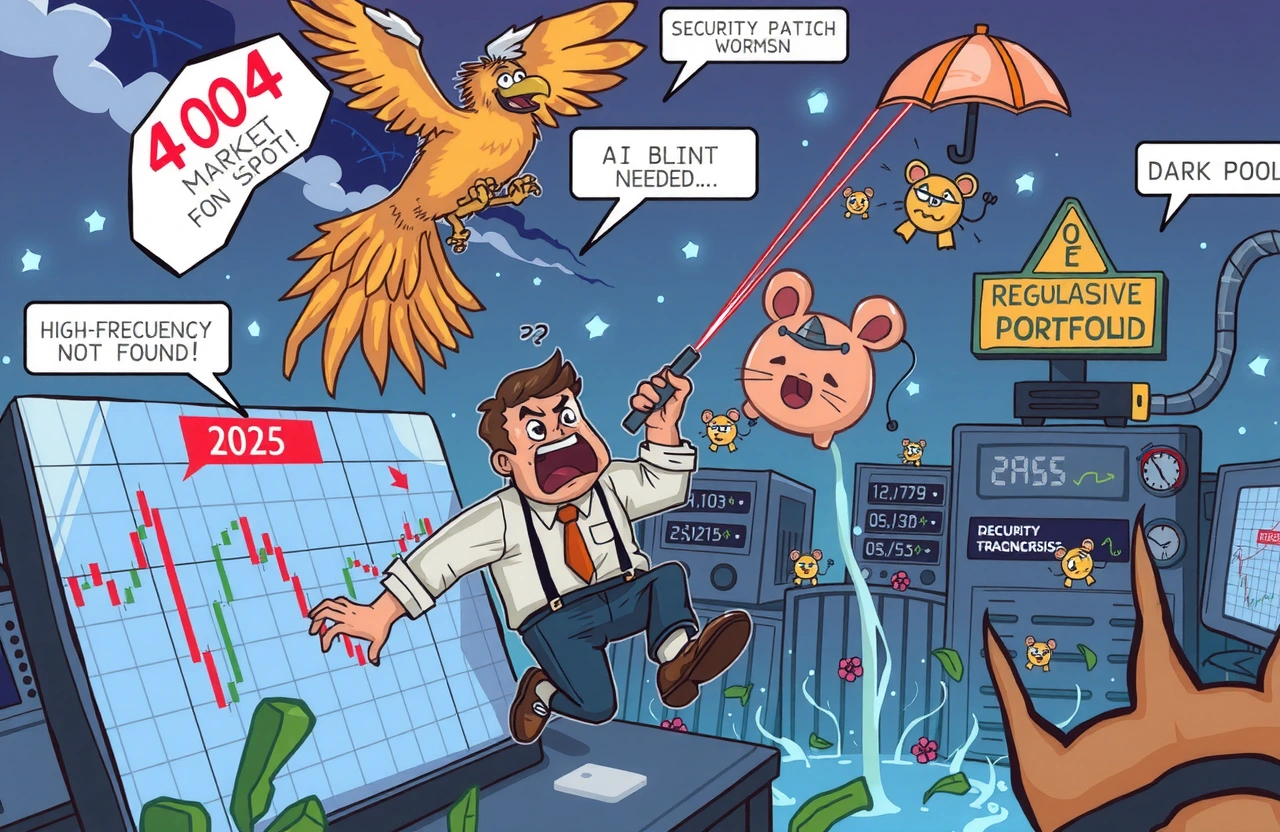Full Article Content Encapsulation for Schema Compliance
The Anatomy of Computational Market Breakdowns
The 21st century financial ecosystem functions through fragile alliances between humans and machines. Understanding market vulnerabilities demands examining where automated systems consistently falter. Research from financial authorities like the Chicago Fed shows complex event-processing systems cause nearly 40% of critical operational crashes. Trading algorithms scanning thousands of signals per second can generate erroneous volume through feedback loops when encountering unprecedented scenarios like extreme geopolitics or climate-driven commodity shock.Even minor incidents compound rapidly:
High-Frequency Trading Glitch Scenarios
Automated traders executing microsecond transactions exhibit predictable failure patterns during market stress:– Quote stuffing overwhelms exchange databases with fake orders– Order book poisoning creates artificial price signals– Aggressive order matching crumbles under volatile velocity
Cascading Operational Risks
Trading firms rely on three increasingly fragile dependency layers:1. Foundational APIs connecting brokerage and exchange infrastructure2. Data normalization systems translating disparate reporting formats3. Risk management algorithms estimating exposure during volatilityEach layer multiplies theoretical failure points—an estimated 60% increase since 2022 according to SEC filings. Connectivity weaknesses become particularly dangerous during foreign exchange interventions or major central bank policy shifts.
2025’s High-Risk Vulnerability Hotspots
Multiple convergence points could transform isolated technical faults into systemic crises during 2025’s projected market surge. Expect particular pressure on cryptocurrency trading venues where regulatory oversight remains inconsistent despite alarming growth patterns. New research indicates crypto exchanges possess five times the technical debt of traditional counterparts, with exchange token collapses already demonstrating how liquidity vanishes when automated market makers malfunction.In traditional markets, securities lending platforms deserve scrutiny:
The Securities Lending Time Bomb
Automated securities lending programs rely on collateral valuation algorithms reflecting real-time prices. When market data streams desynchronize during volatility—as occurred during multiple 2023 flash crashes—collateral packages appear inadequate triggering mass recall events that liquidate positions across portfolios.Beyond specific venues, global liquidity fragmentation poses structural concerns:– Post-Brexit market fragmentation creates synchronization gaps– Emerging economy exchange stress propagates globally– Dark pool pricing mechanisms respond unpredictably to volume surgesEach represents undiscovered market vulnerabilities requiring immediate attention.
Artificial Intelligence’s Blind Spots
Machine learning trading models develop unique instability patterns according to MIT quantitative finance studies. Neural networks trained on historical data frequently misinterpret novel events—like unexpected electoral outcomes or space-weather-induced satellite failures. Without supervised learning safeguards, such thinking engines might generate self-reinforcing panic cycles across interconnected markets.
Diagnosing Technical Weaknesses in Real Trading Ecosystems
The most dangerous flaws emerge when technologies interact unpredictably. Industry assessments documented six major 2023 incidents tracing back to API incompatibilities between broker front-ends and exchange matching engines. Each caused erroneous block trades executing significantly off-market rates.
Data Poisoning Episodes
False information injections corrupt algorithm logic:– Phantom earnings reports from hacked newswires trigger algorithm sell-offs– Compromised geolocation data misrepresents supply chain realities– Satellite imagery spoofing destabilizes commodity pricing modelsEach year an estimated 15% of algorithmic trades originate from contaminated data sources according to cybersecurity analysts at Fireye.
Blockchain’s Settlement Dilemma
Distributed ledger settlement platforms introduce novel risk dimensions:– Smart contract bugs unilaterally freezing assets– Fork vulnerabilities causing duplicate transactions– Orphaned blockchain executions requiring centralized rollbacksProjects must undergo third-party vulnerability assessments before implementation. Regular pen testing reduces exploit probability by approximately 80%.
Building Defensive Frameworks Against Computational Crises
Investors need armor against disruptions beyond traditional diversification. Protective methodologies utilize staggered redundancies and specialized instruments monitoring trading extremities.Implement automatic three-tier warning systems:
Algorithmic Oversight Protocols
Protect positions through layered circuit breakers:– Position quantity limitations preventing catastrophic single orders– Independent velocity monitors restricting trade barrage deployments– Cross-exchange sanity checks validating execution legitimacyEnhanced surveillance platforms like Nasdaq TradeGuard™ actively detect anomalous trading rhythms indicating technological distress.
Shock-Absorbing Asset Allocation
Defensive portfolio allocations to absorb technical accidents:– Physical assets immune to digital disruption– Deep-value preferred shares minimizing capital erosion– Collateralized loan obligations generating cash through counterparty failuresThis approach treats market vulnerabilities not as speculative threats but permanent structural considerations. Absolute avoidance of assets with poor operational transparency dramatically reduces exposure.
Regulatory Safeguards and Their Dangerous Delays
Concerted regulatory responses trail technical innovation. Critical decisions face roadblocks:
The AI Audit Impasse
No standardized methodology exists to evaluate probabilistic machine learning trading behavior across jurisdictions. Regulatory proposals recommend independent third-party validations. Organizations like FINRA establish international working groups amid building pressures.
Exchange Interoperability Mandates
Fragmented exchanges lack consistent messaging frameworks during volatility periods. When European exchanges activated extreme volatility suspensions during the 2023 banking crisis, considerable arbitration opportunities emerged compounding losses throughout institutional holdings. Emerging global coordination pacts seek universal pause protocols by late 2025.
Individual Protection Tools
The SEC’s forthcoming Retail Protection Dashboard highlights: – Transaction reversibility protocols – Brokerage cybersecurity ratings – Insurance against exchange technology failuresHowever actionable safeguards remain 18–24 months from implementation per recent congressional testimony, creating immediate vulnerability windows.
Defensive Investment Actions for 2025
Develop countermeasures before systemic stress events escalate:
Portfolio Surgery Protocols
Simplify positions exposed to automated accidents:– Eliminate cross-component derivatives vulnerable to pricing engine failures– Reduce exposure to credit-default swaps dependent on computational triggers– Hedge against correlated failures using ramp-out stop loss regimes
Continuous Vulnerability Monitoring
Establish routine technological due diligence:– Monthly reviews of broker cybersecurity certifications– Bi-annual quant model validations– Peer comparison testing against established commercial toolsCrucially, maintain dedicated high-liquidity reserves to exploit artificial valuations created during technical accidents. Savvy investors profit tremendously from irrational algorithmic selloffs when possessing readiness capital.
Expert Network Engagement
Form relationships addressing three critical dimensions:1. Exchange architecture advisors explaining intrinsic systemic risks2. Quantitative finance specialists auditing proprietary algorithms3. Distributed ledger auditors validating blockchain tokenization projectsQualitative intelligence provides irreplaceable context beyond technical indicators.Immediate action matters profoundly. Consult certified financial advisors about vulnerability stress-testing frameworks and crisis exploitation techniques. Follow securities authority alerts through FINRA email notifications documenting emergent threats. Ultimately portfolio survival may depend less on predicting markets than anticipating machines’ predictable failures.



